SD cards extend your device’s storage, making it easy to store many photos and videos. Swapping cards lets you keep a large library of images to view anytime. They give you flexibility in storage space, meaning you can save more memories. Unfortunately, SD cards can encounter data loss at one point or another. Thankfully, recovering deleted photos from an SD card is possible, and we’ll show you how to do it.
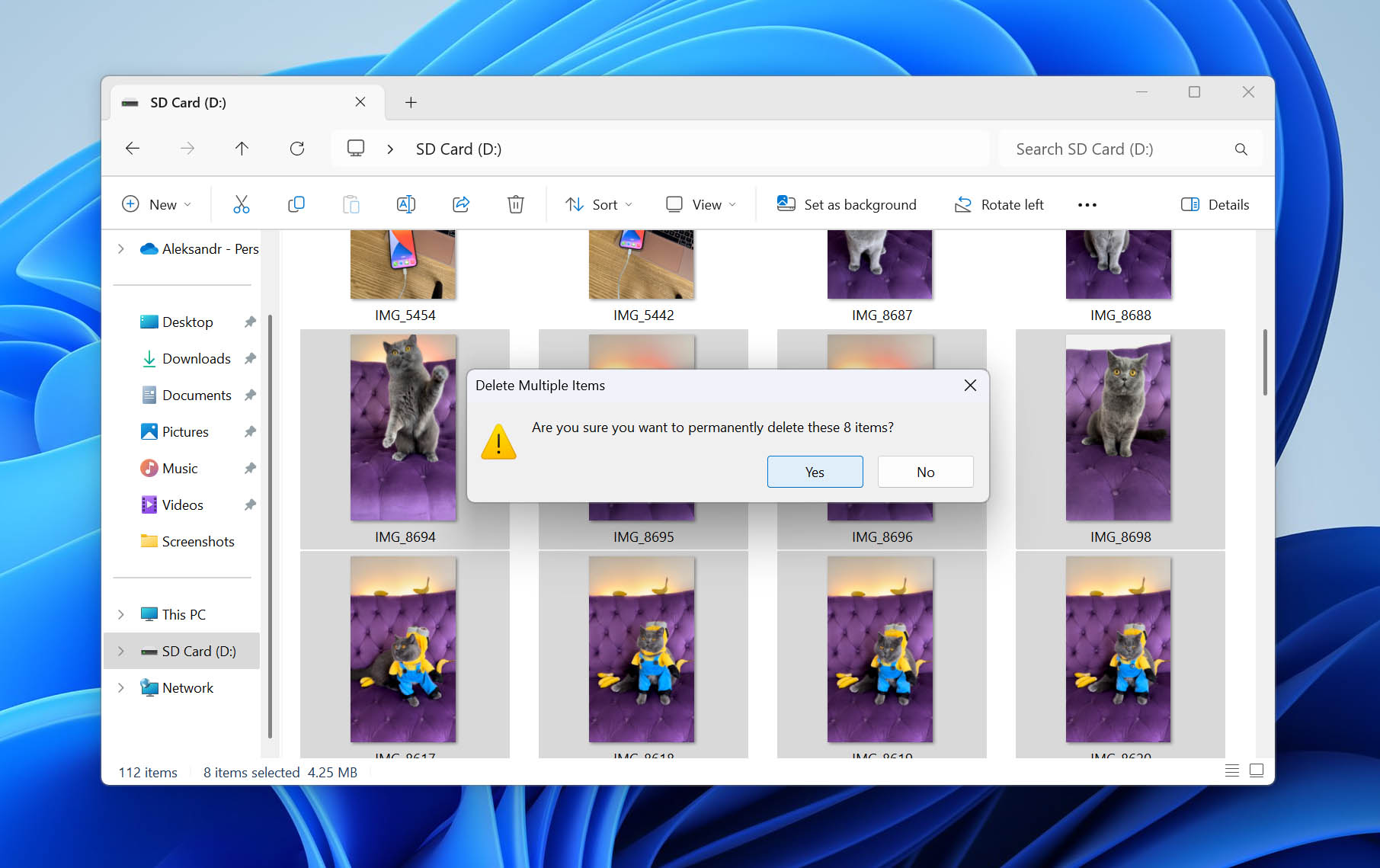
Why Would I Need to Recover Deleted Photos from an SD Card?
There are numerous reasons why you would need to recover photos from an SD card. All of those reasons are bad, but in this case, there are varying levels of bad. Here are a few reasons why data loss can occur on a digital camera, phone, or other camera-equipped device:
- You might need to perform SD card photo recovery due to the accidental deletion of photos. If you delete photos on your phone directly, you may be able to recover photos from the SD card for free, as most phones have a ‘Recently deleted’ folder. Otherwise, if the photos were deleted on a PC or camera, the files will need to be recovered with data recovery software if a backup is not available.
- Photo loss due to formatting results in the photos becoming deleted and, therefore, inaccessible. In most instances, this is because you’ve mistakenly chosen the wrong card to format. Or, your phone displayed a message requesting you to format due to damage on the card. Either way, the files are recoverable with software so long as (a) they haven’t been overwritten, and (b) it was a quick format – not a full format.
- Corruption is a major culprit for data loss. When your SD card becomes corrupted, the file system it uses becomes unusable, and your data can no longer be found through traditional means. Sometimes the SD card doesn’t show up at all. In this case, data recovery software is the best option, as attempting to fix an SD card that’s not showing up (or showing other signs of corruption) could cause further damage.
If you need to recover permanently deleted photos from your memory card, follow these methods based on your OS:
6 Ways to Recover Deleted Photos From an SD Card
Depending on the operating system and device you’re using, there are various ways to recover deleted photos from an SD card. We’ve included a few methods below to give you some options that will work on all types of cards, including PNY, Lexar, Kingston, and SanDisk SD cards.
Way 1: Recover Photos Using Data Recovery Software
To recover deleted photos from your SD card, using a data recovery tool is one of the best options. More specifically, we recommend using Disk Drill SD Card Recovery tool, as it uses several scanning methods to pull up as many photos as it can find. You also have the chance to preview your deleted photos and make sure they’re still intact – a very valuable feature when it comes to recovering photos in bulk.
Let’s take a look at how easy it is to use this data recovery tool to recover deleted photos from an SD card.
Steps to Recover Deleted Pictures from an SD Card on Windows
- Download and install the Disk Drill onto your Windows computer. The free version allows you to preview recoverable files and actually recover up to 100 MB of data for free, without upgrading to the Pro version. This is usually enough to test the app and restore personal files.
- Connect the SD Card to your Windows PC using an SD card adapter, or the built-in SD card slot if your computer has one.
- Launch Disk Drill and select your memory card from the list of available disks. Once you’ve selected the card, click on Search for lost data.
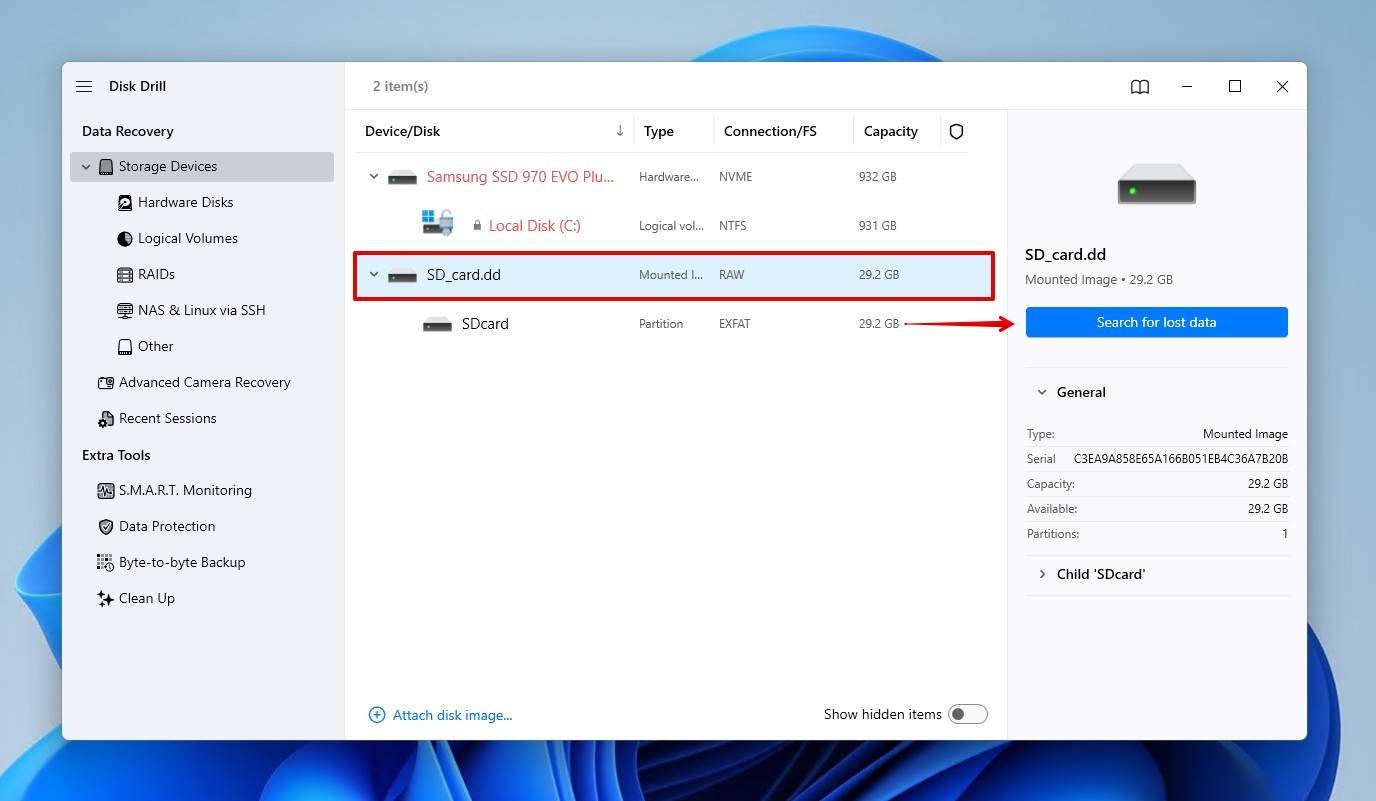
- Select a scan type. If you’re recovering media files, like photos and videos, the Advanced Camera Recovery option offers the best chance of success. Otherwise, if you’re recovering all types of files, the Universal Scan is the ideal choice.
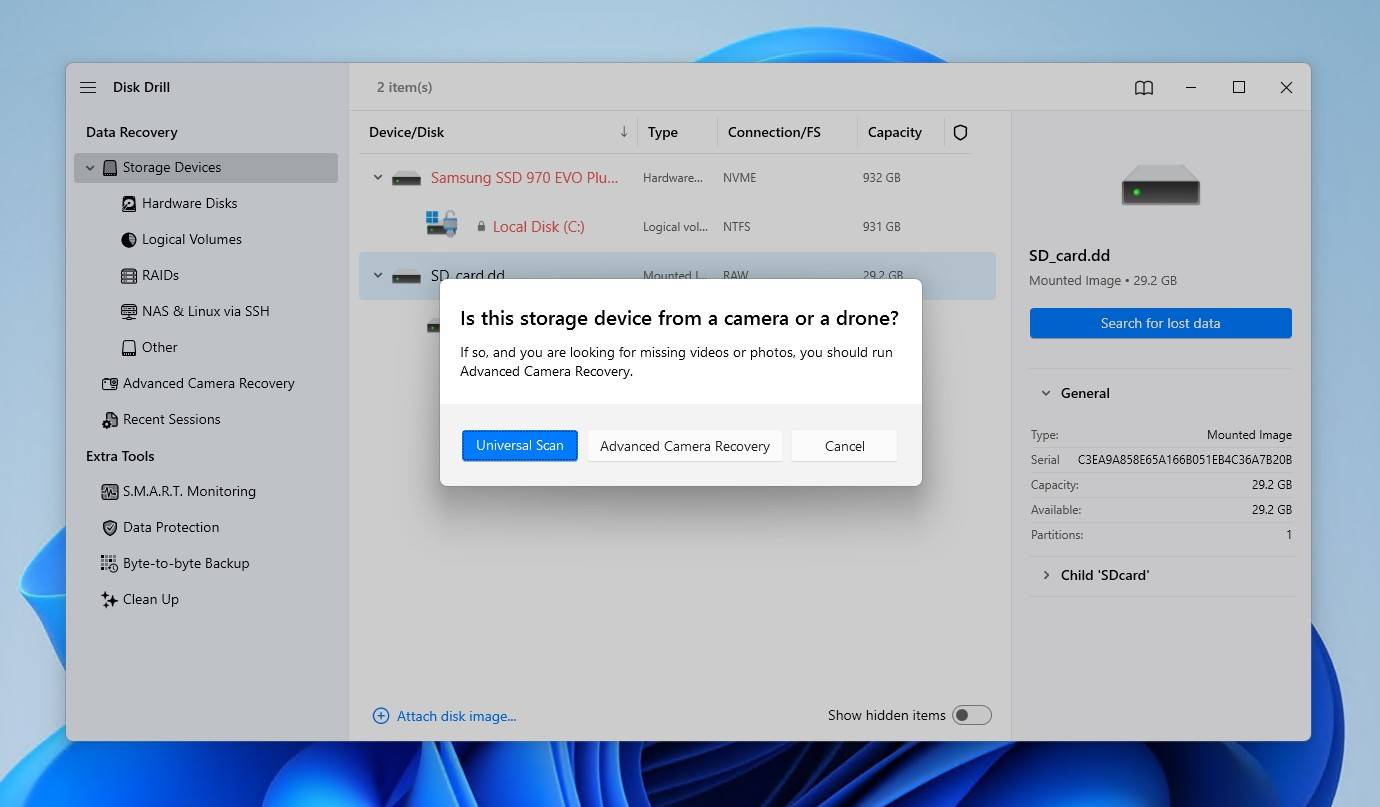
- Wait for the scan process to complete, and then click Review found items.
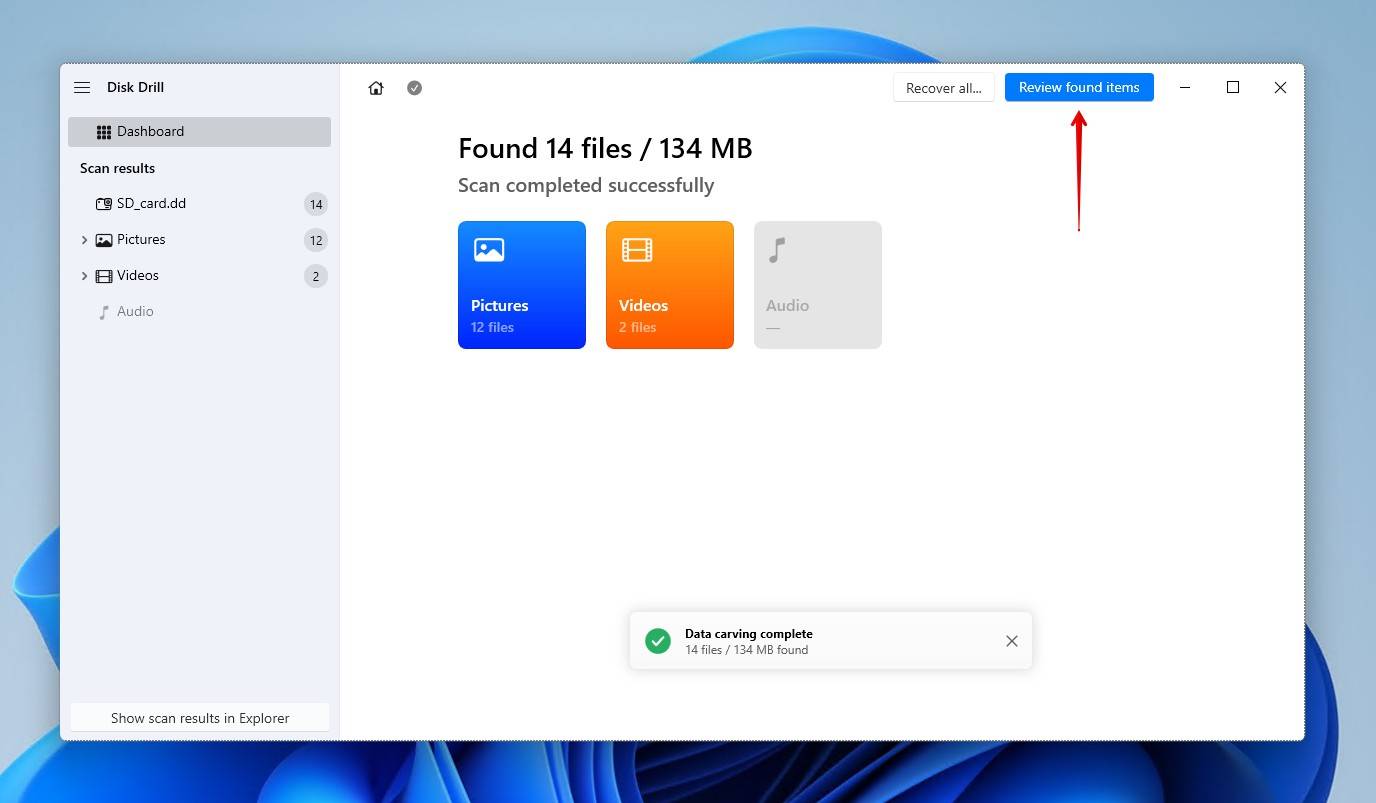
- Browse the photos that Disk Drill found on the SD card once the scan has finished. Click on the Preview icon to look at the pictures before you choose to recover them.
- Check the files that you would like to recover. Make use of the filters to organize the data, either using the Pictures category on the left, or searching the file type in the search box. When ready, click the Recover button.
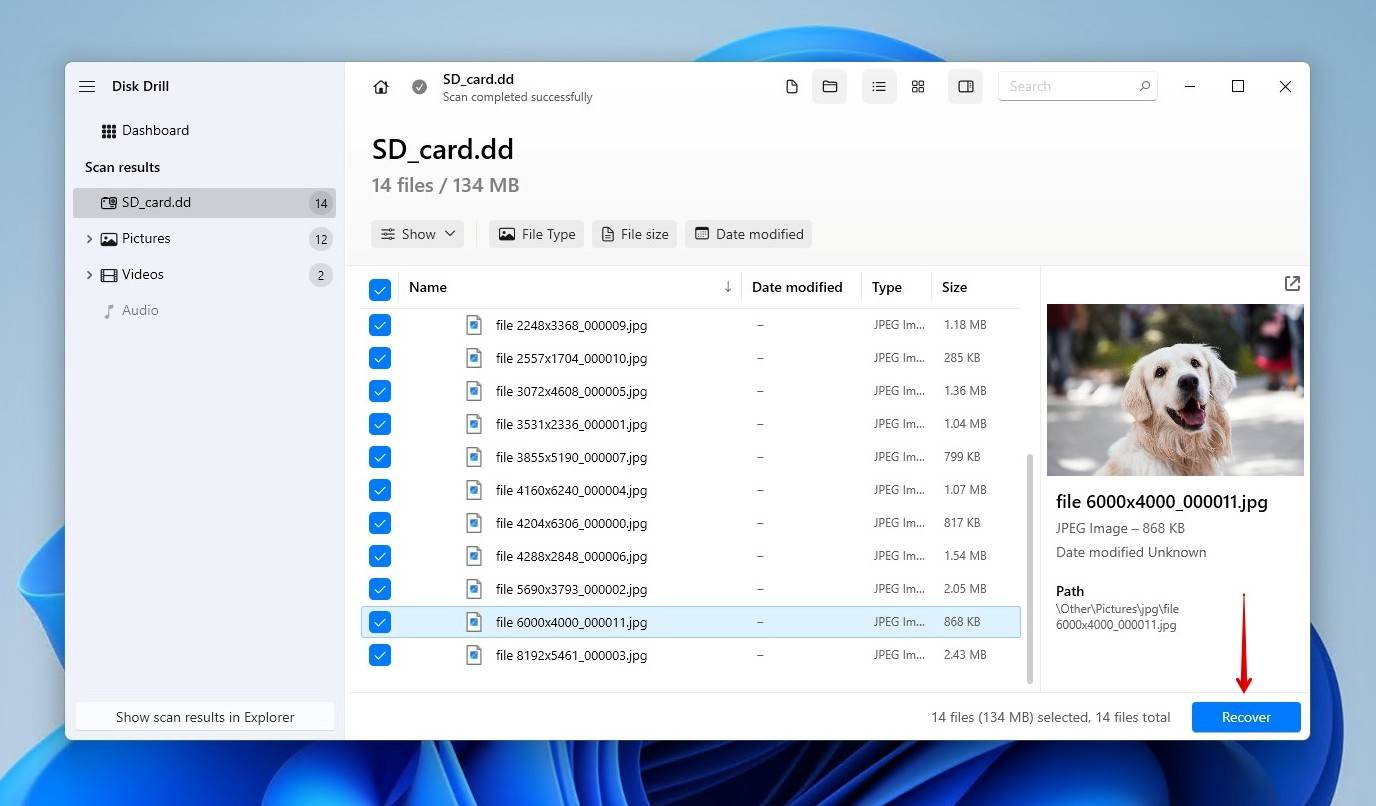
- Choose a suitable recovery destination for the files on a separate storage device.
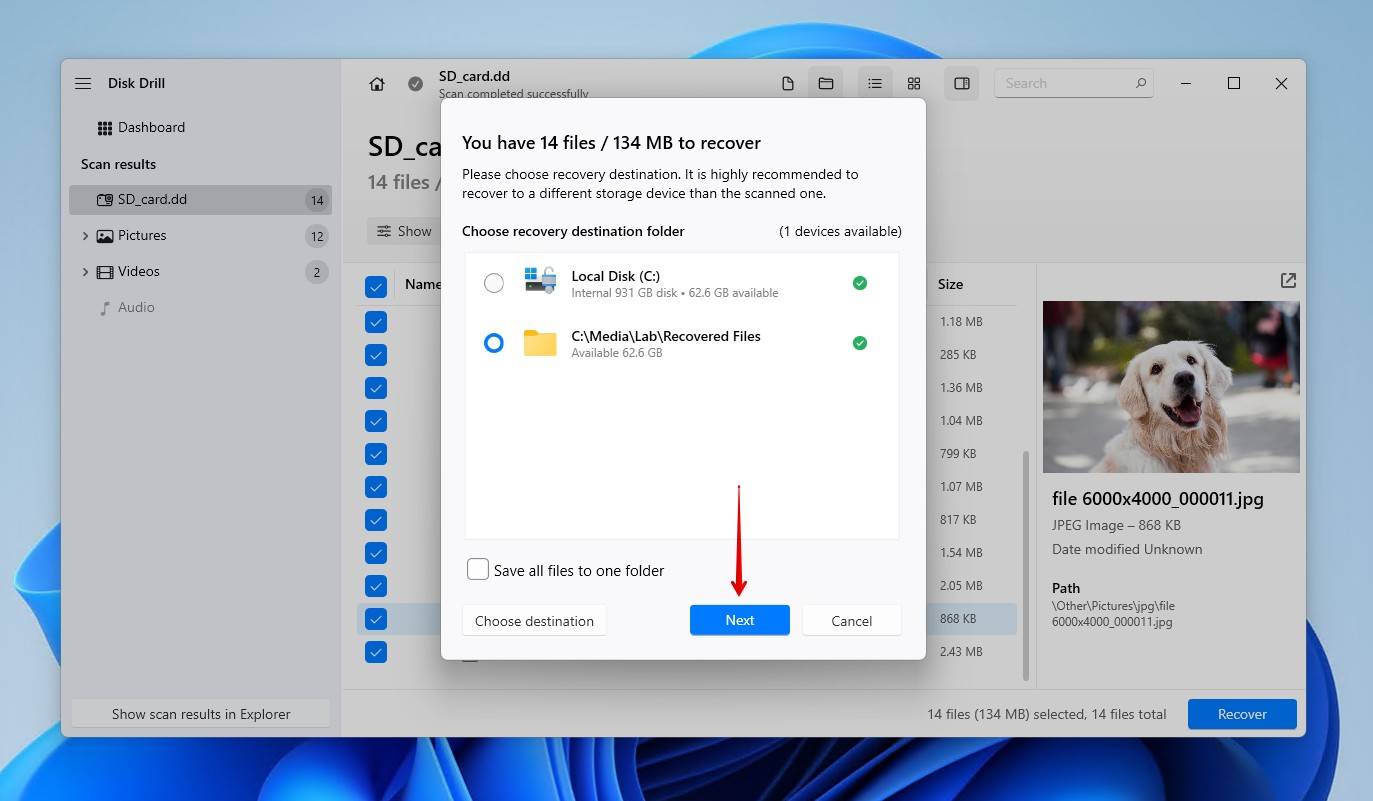
Steps to Recover Deleted Photos from an SD card on Mac
Mac users can download a free version of Disk Drill that allows them to preview the files that it can recover before any financial investment is required. If the files you need are recoverable, you can opt to purchase the Pro version of Disk Drill and perform the actual data recovery.
This is how to recover photos from an SD card on Mac:
- Download and install Disk Drill onto your Mac.
- Connect the SD card that held the deleted photos to your Mac using an SD card reader or port.
- Select the SD card from the list of disks presented by Disk Drill. In this case, we’re going to select our SD card but it could be any storage device.
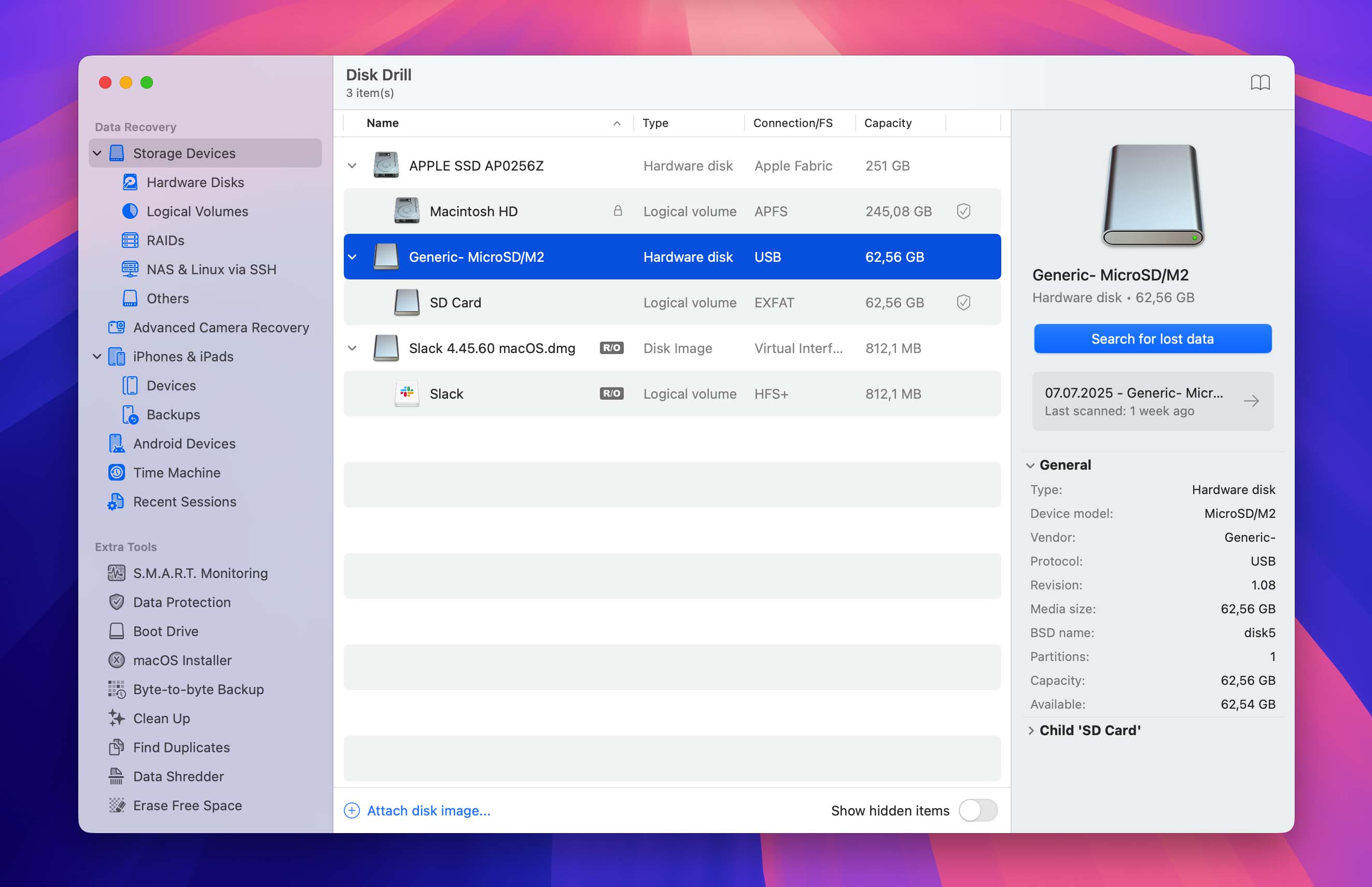
- Choose a scan type. Advanced Camera Recovery is best for recovering photos and videos, and the Universal Scan is great for recovering anything and everything it can find.
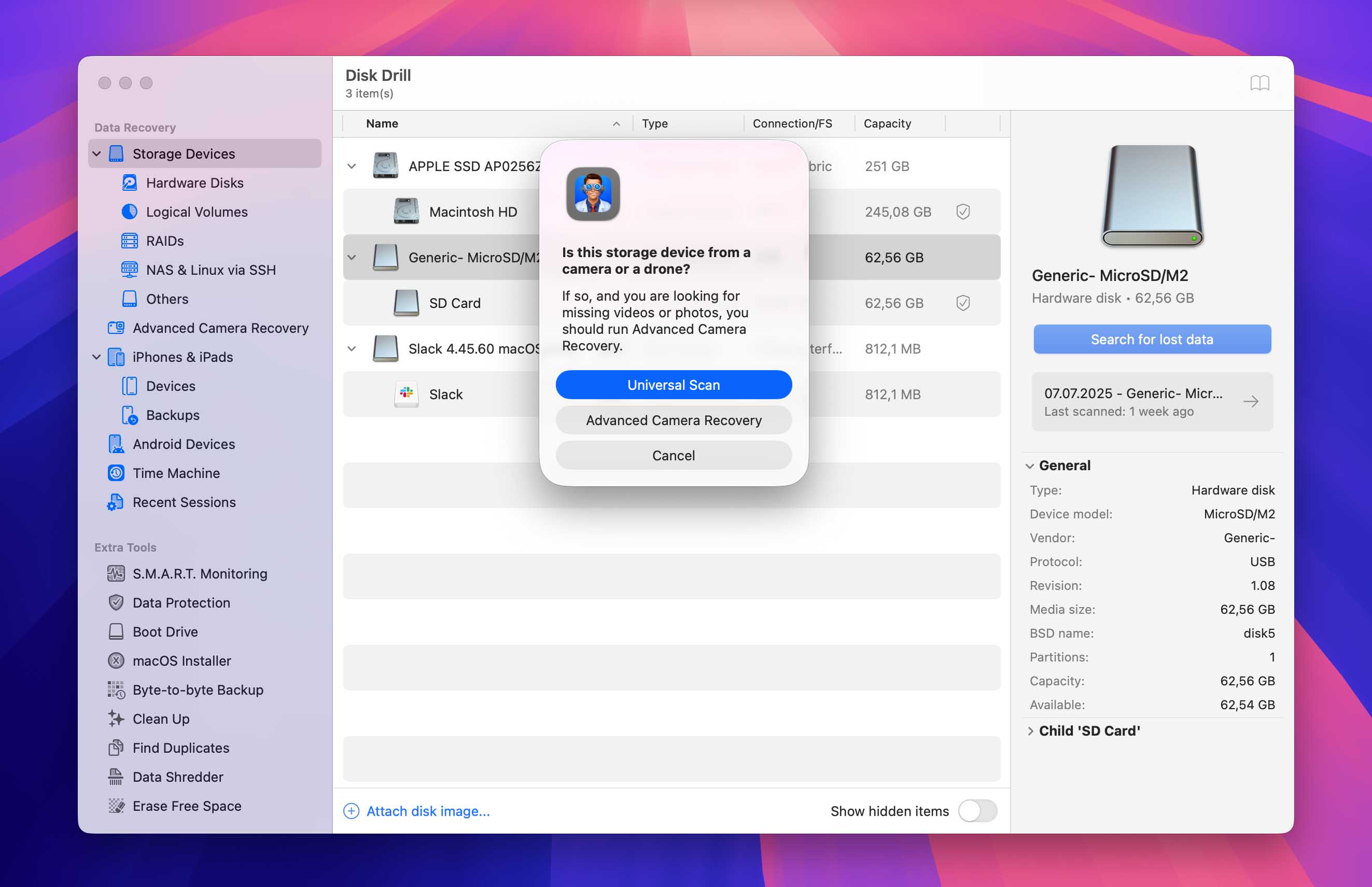
- Wait for the scan process to complete. This can take some time depending on the size of the SD card and the type of connection.
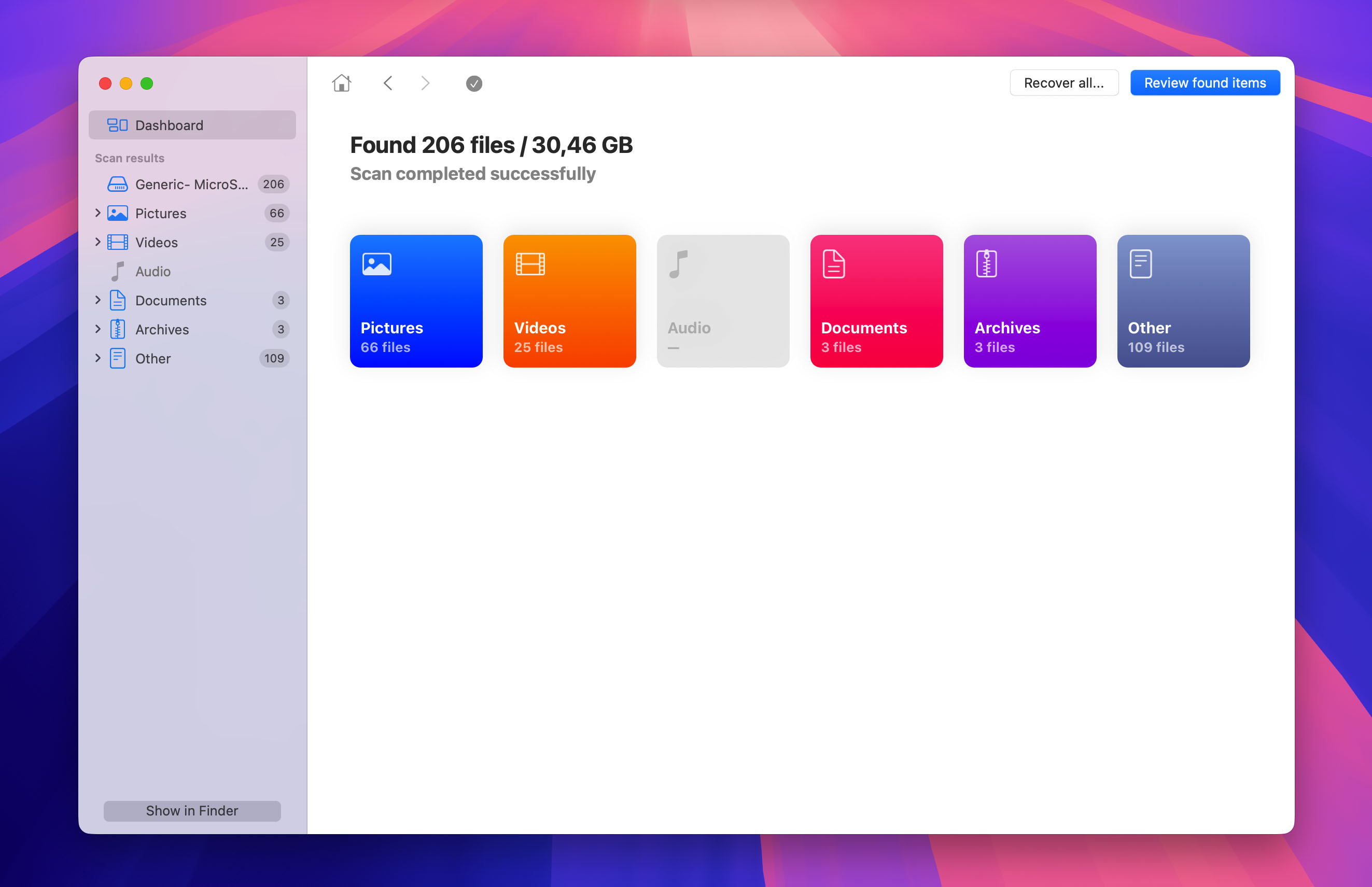
- Now that the scan is done, review the items that Disk Drill was able to recover from your SD card. You can browse your files, use the search box to find something, and also use the Preview function to look at something before recovering it.
- Look through the files that you want to recover from your SD card and then checkmark the box to select them for recovery. Now, click on the blue Recover button to recover the files and put them back onto your Mac.

- Choose an appropriate location for recovery. Make sure you don’t recover the photos to the same SD card, as it can corrupt them.
Way 2: Recover Pictures Using an Android Data Recovery App
If you need to recover deleted photos from an SD card that was used to expand the storage space of your Android smartphone or tablet, then you can use an Android data recovery app like DiskDigger photo recovery. It’s free software, but a Pro version is also available.
As DiskDigger allows you to recover photos from an SD card on Android and save it to internal memory, this is a very useful method for those who don’t have access to a computer. However, In order to scan your SD card, DiskDigger will require root access. If your device is not rooted, it will only be able to recover files from caches and thumbnails.
Here’s how to recover photos from an SD card with DiskDigger:
- Download the app from the Play Store.
- Launch it and scan your SD card (usually appears as “/mnt/sdcard” or something similar).
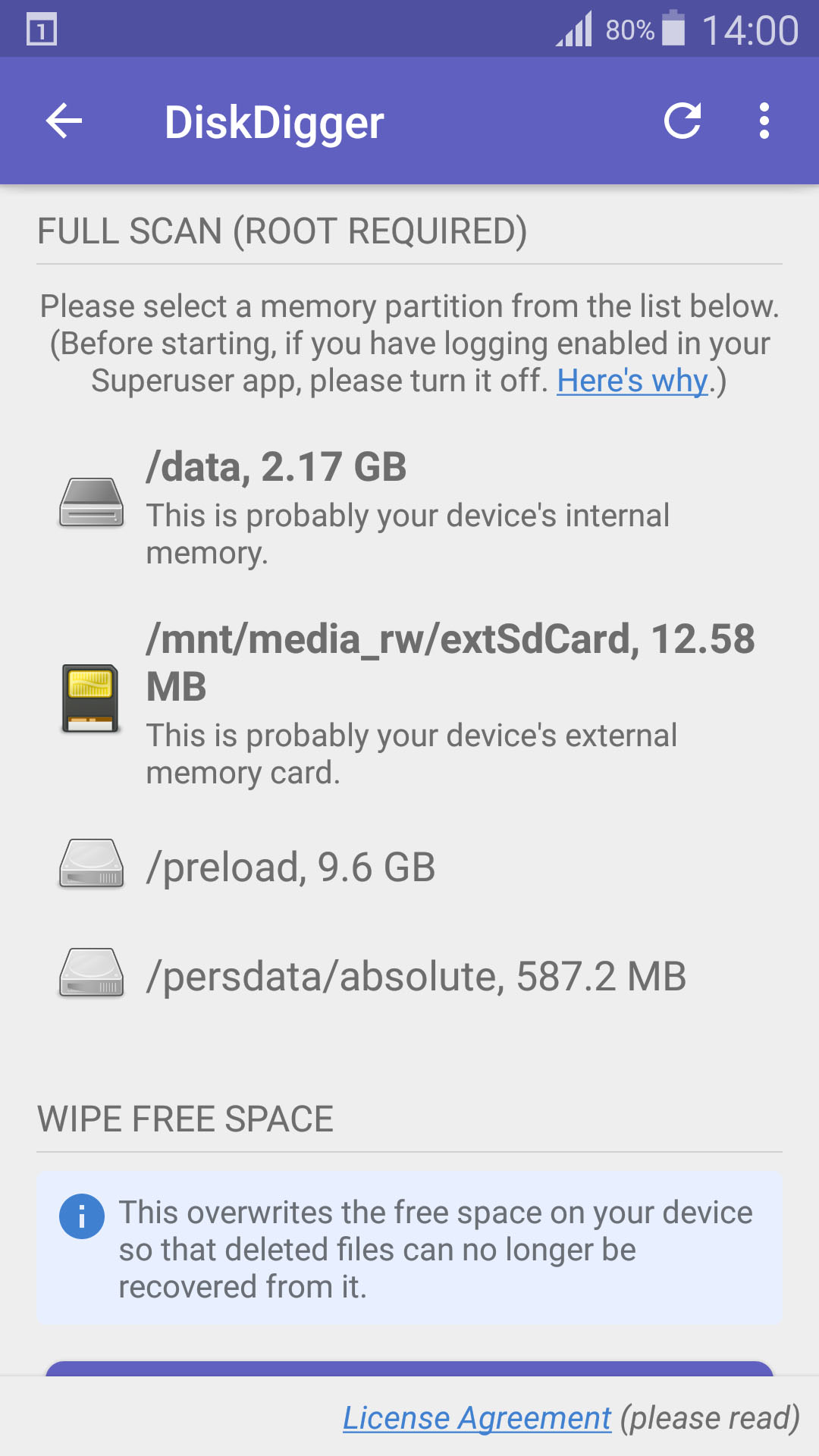
- Specify the file types you would like to search for and tap OK.
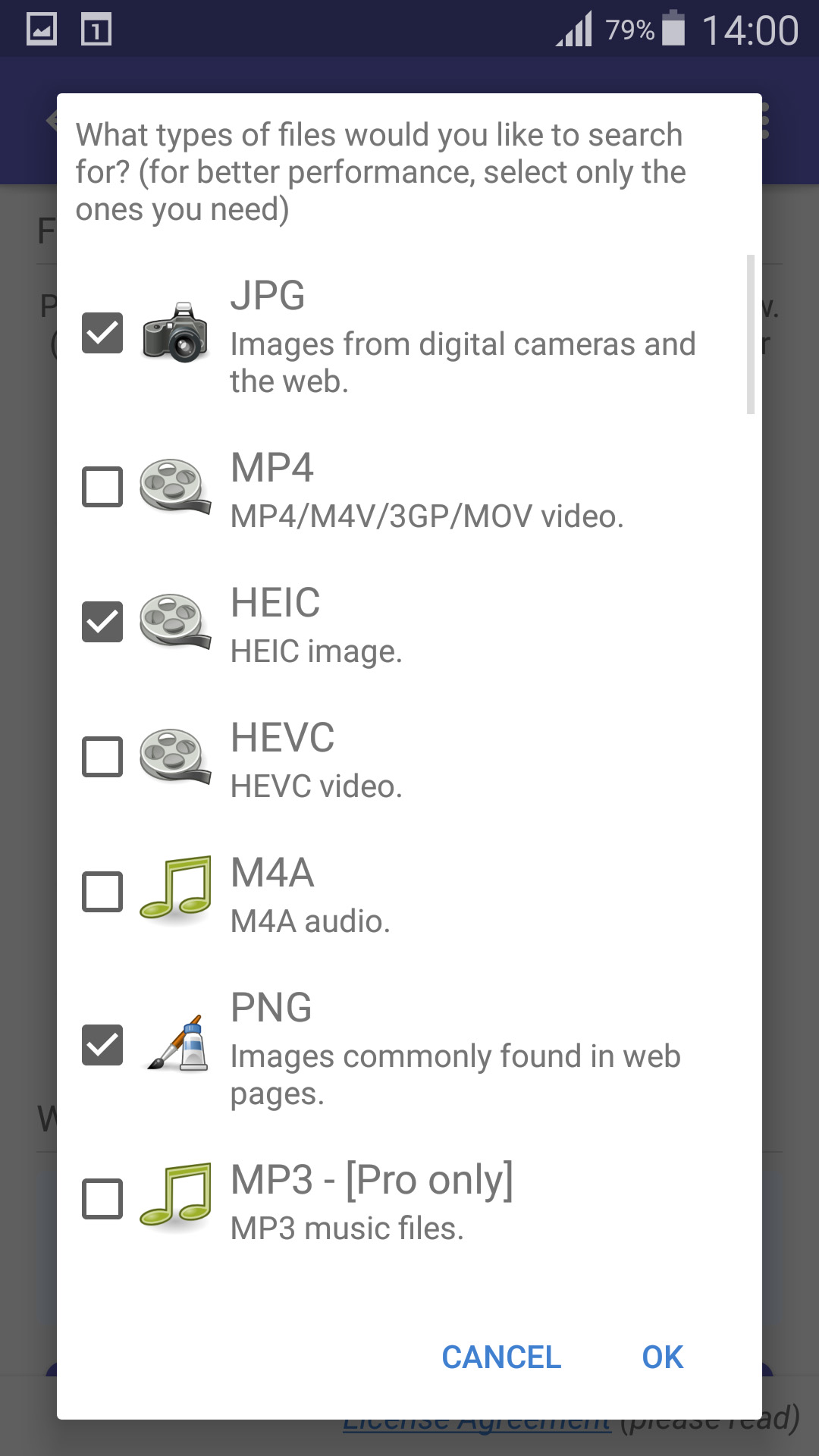
- Choose the files you want to recover.
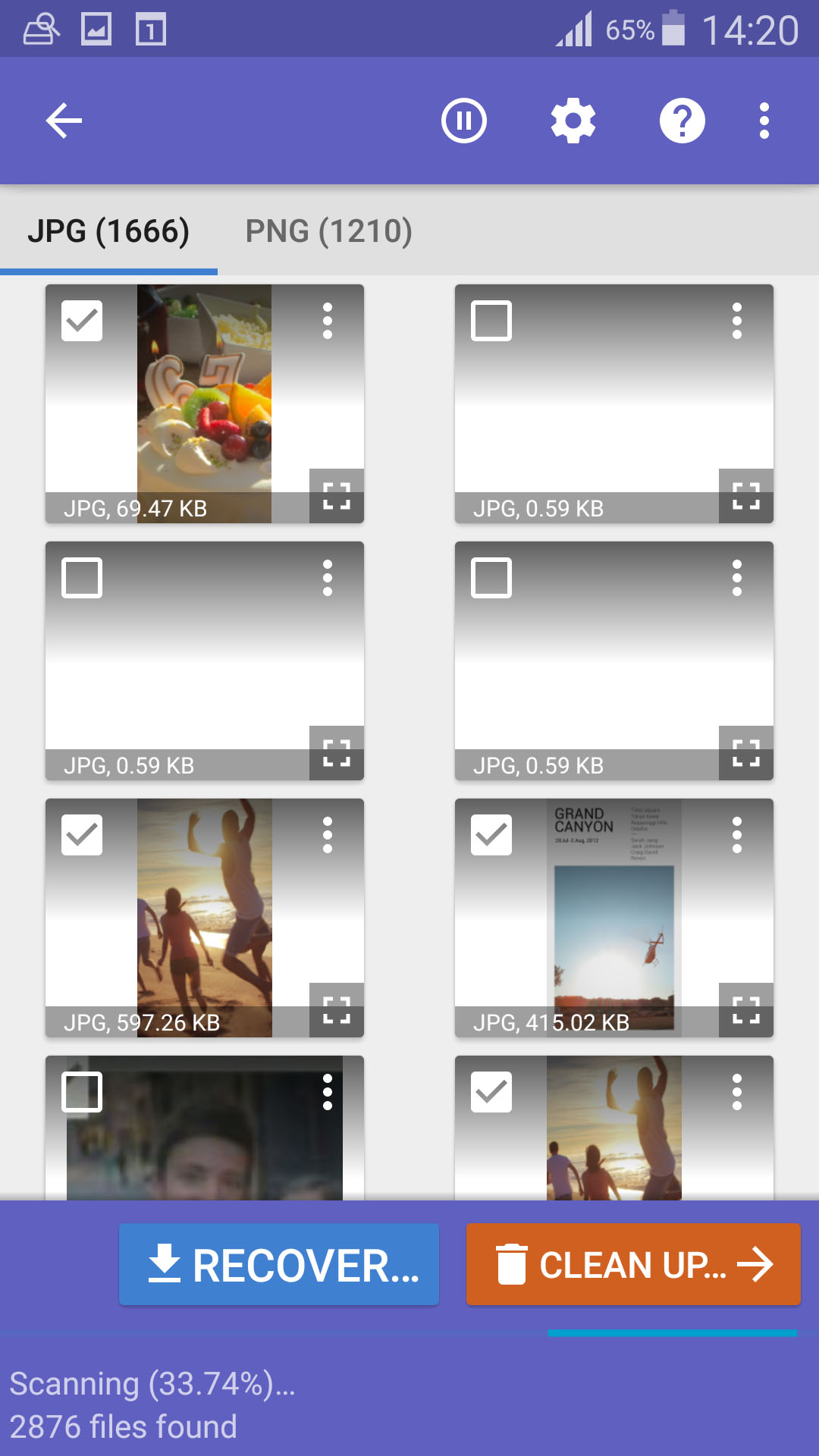
- Tap the Recover button to save them to your device.
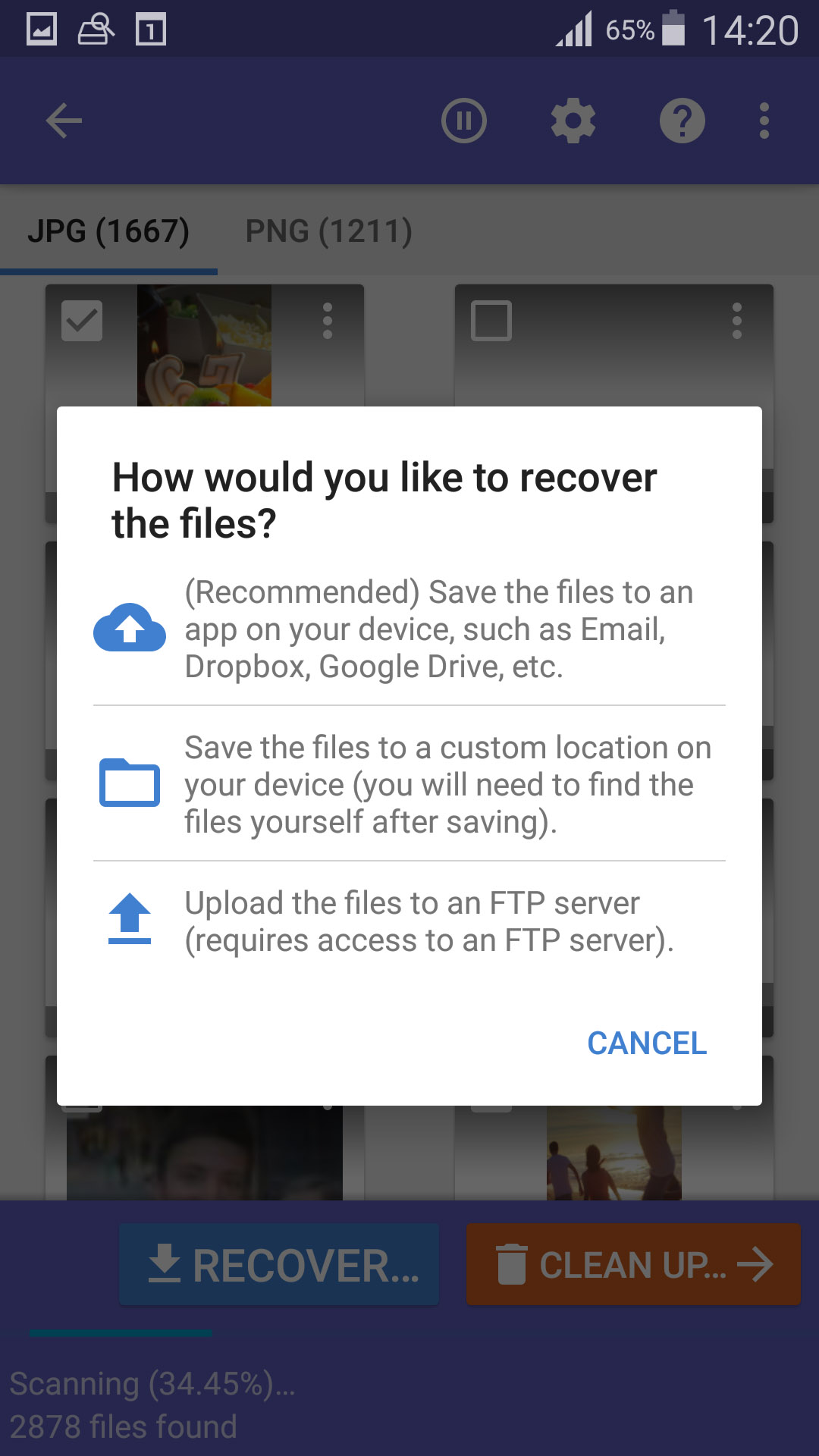
For the best results, your device should be rooted, and you should use DiskDigger Pro instead of the free version. Still, don’t expect to find as many deleted photos as with desktop data recovery software like Disk Drill.
Way 3: Restore Photos from a Backup
An SD card can be used for long-term storage of digital photos or for expanded capacity on a photographic device. If you have just taken a photo and then deleted it there was probably no time to have taken a backup of your photos. On the other hand, if it’s a card you use for transferring photos to be viewed on different devices and the pictures have been resident on the card for some time, it would be best for you to create a backup of those photos.
Retrieve from a Backup on Windows
On Windows 10 and 11, you can use the native backup utility File History to back up your personal files. It’s very uncommon for someone to not only manually enable File History, but also select the SD card for back up. Instead, we’re going to rely on the hope that you copied photos from the SD card to your computer at least once. If you did, and the folder which you stored the photos was included in the File History backup, you can then restore the deleted photos.
This is how to recover deleted photos from an SD card:
- Open Start and search File History. Open it.
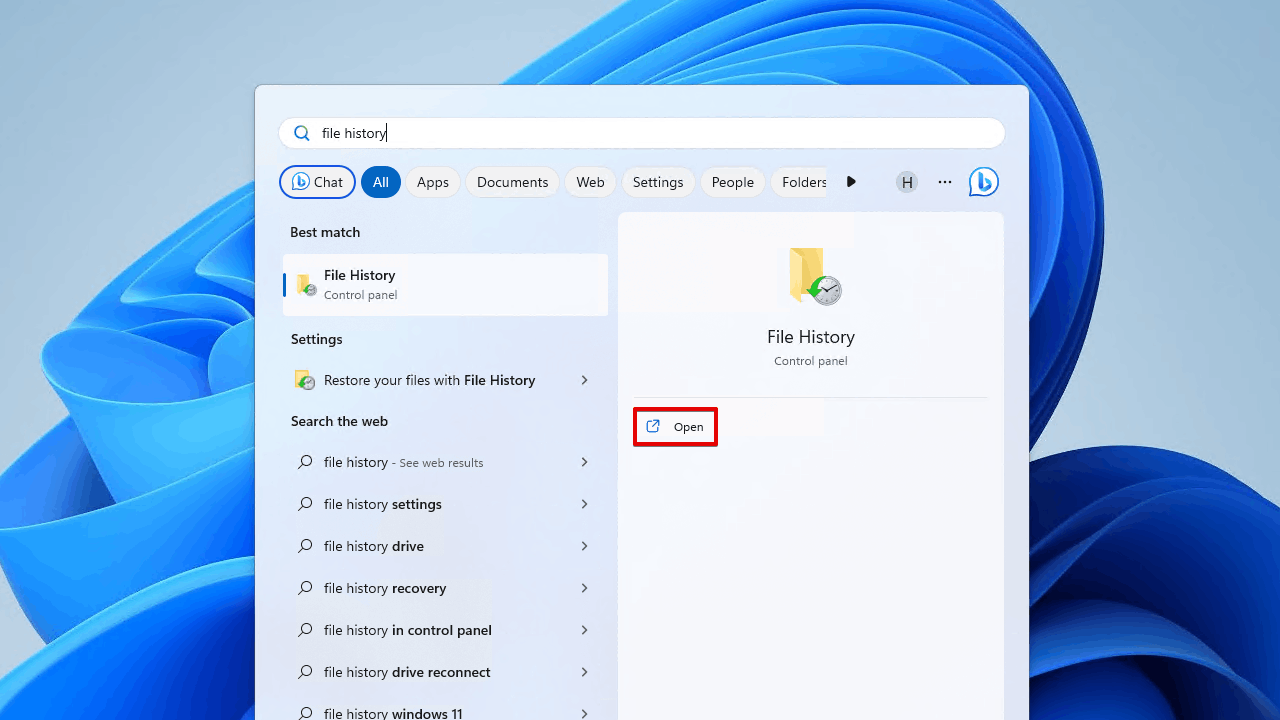
- Click Restore personal file.
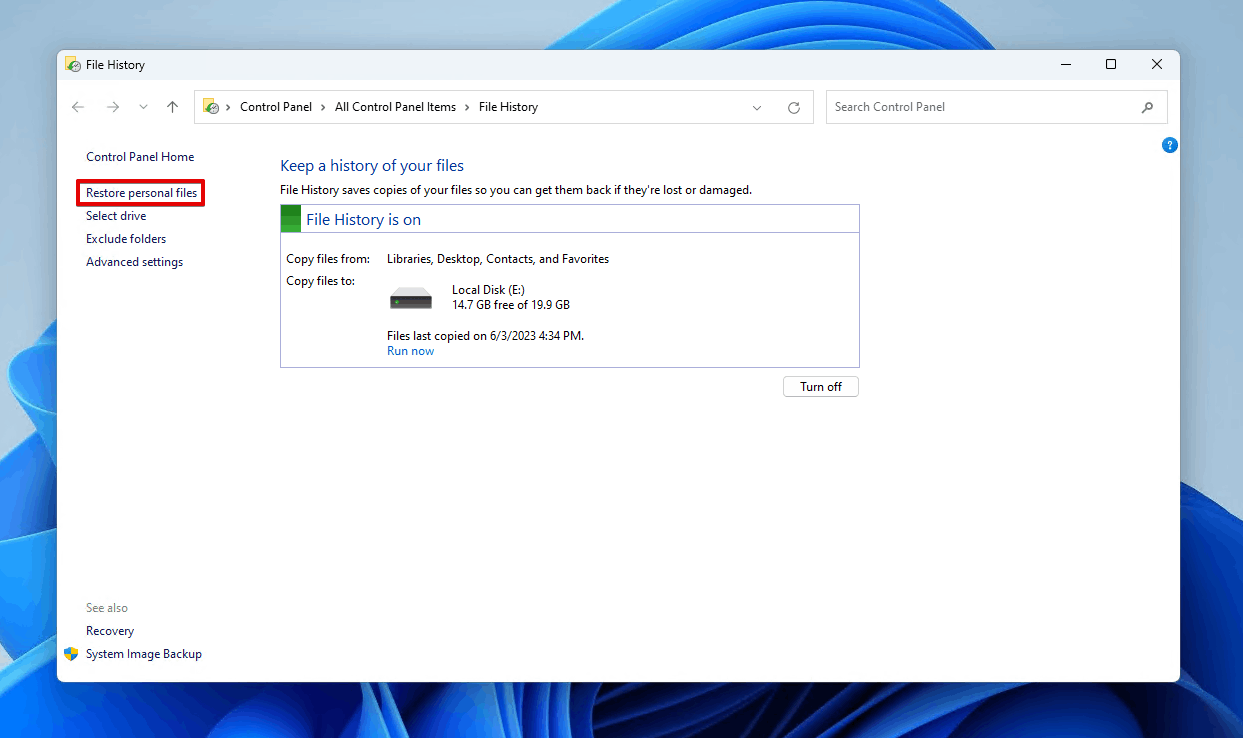
- Navigate to the backed-up photos and select the ones you want to restore.
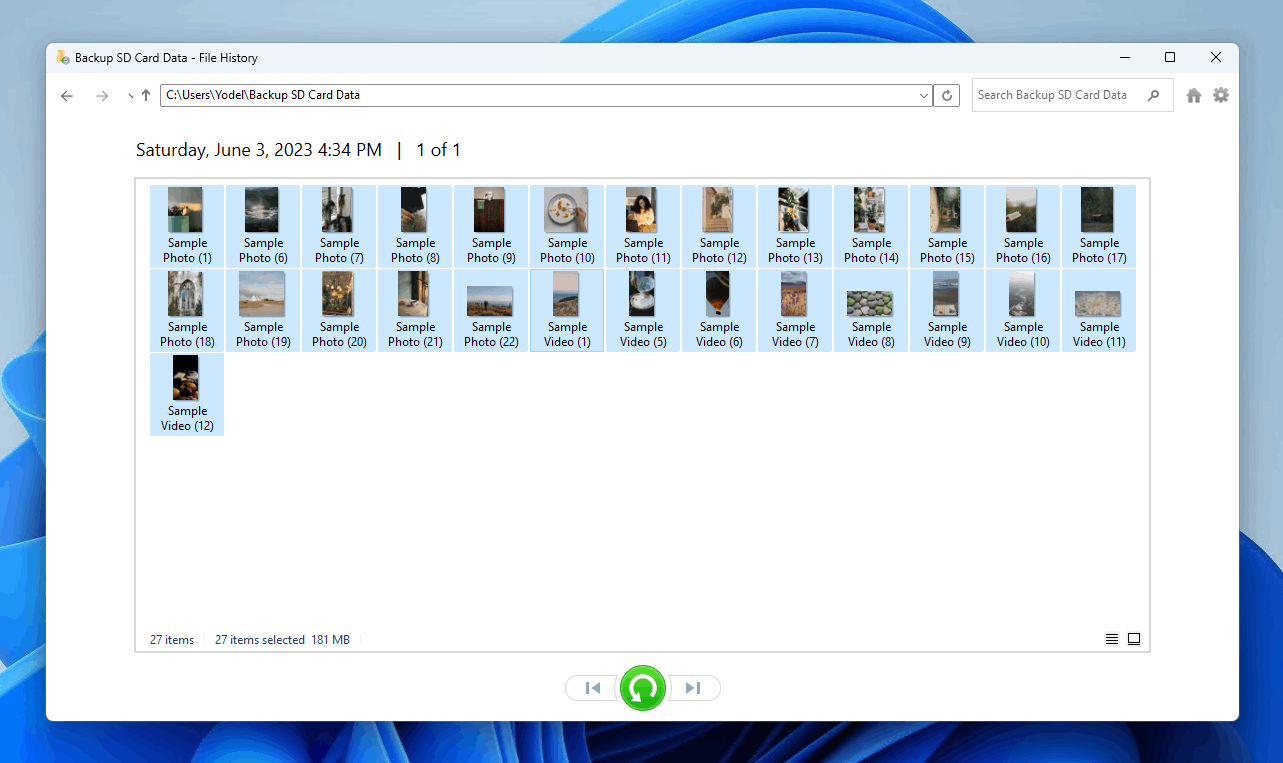
- Right-click the green Restore button and either click Restore to restore them to the original location, or Restore to in order to choose a custom destination.
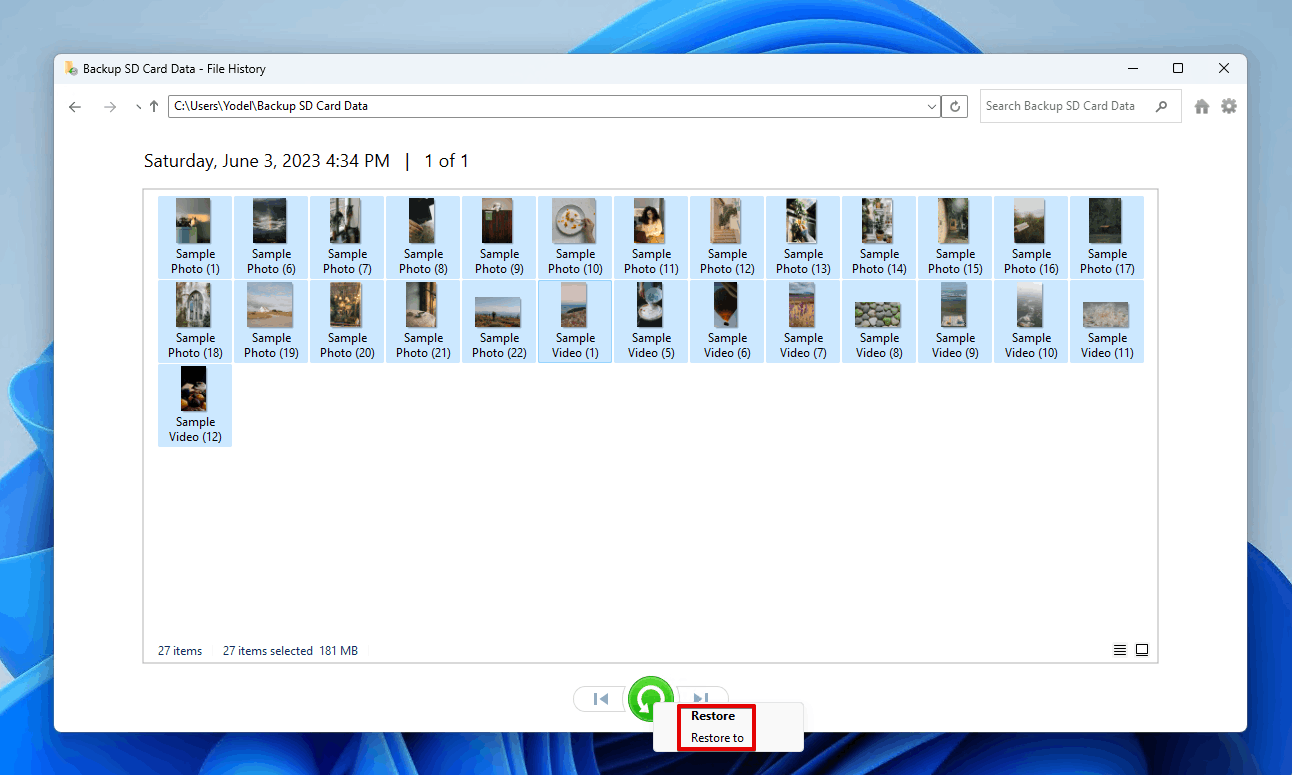
Alternatively, if you previously copied or moved the files from your SD card to your computer, try searching for the photos instead, as they may reside in a subfolder somewhere. Using File Explorer, you can enter the name of the photo or folder you’re looking for into the search box. Or, you can pull all files by a specific type if you cannot remember the name.
Restore from a Backup on Mac
Time Machine is the primary backup feature for macOS. It can be used to automatically back up your personal data, allowing you to easily restore files that have become deleted, damaged, or otherwise inaccessible.
You can recover photos that were deleted from your SD card using Time Machine. Like with File History, it’s unlikely that you chose to select the SD card for backup. It’s much more likely if you copied the photos to your computer at some point, allowing Time Machine to create a backup of them.
If you want to learn more about how to use Time Machine, Apple has a walkthrough which you can view here.
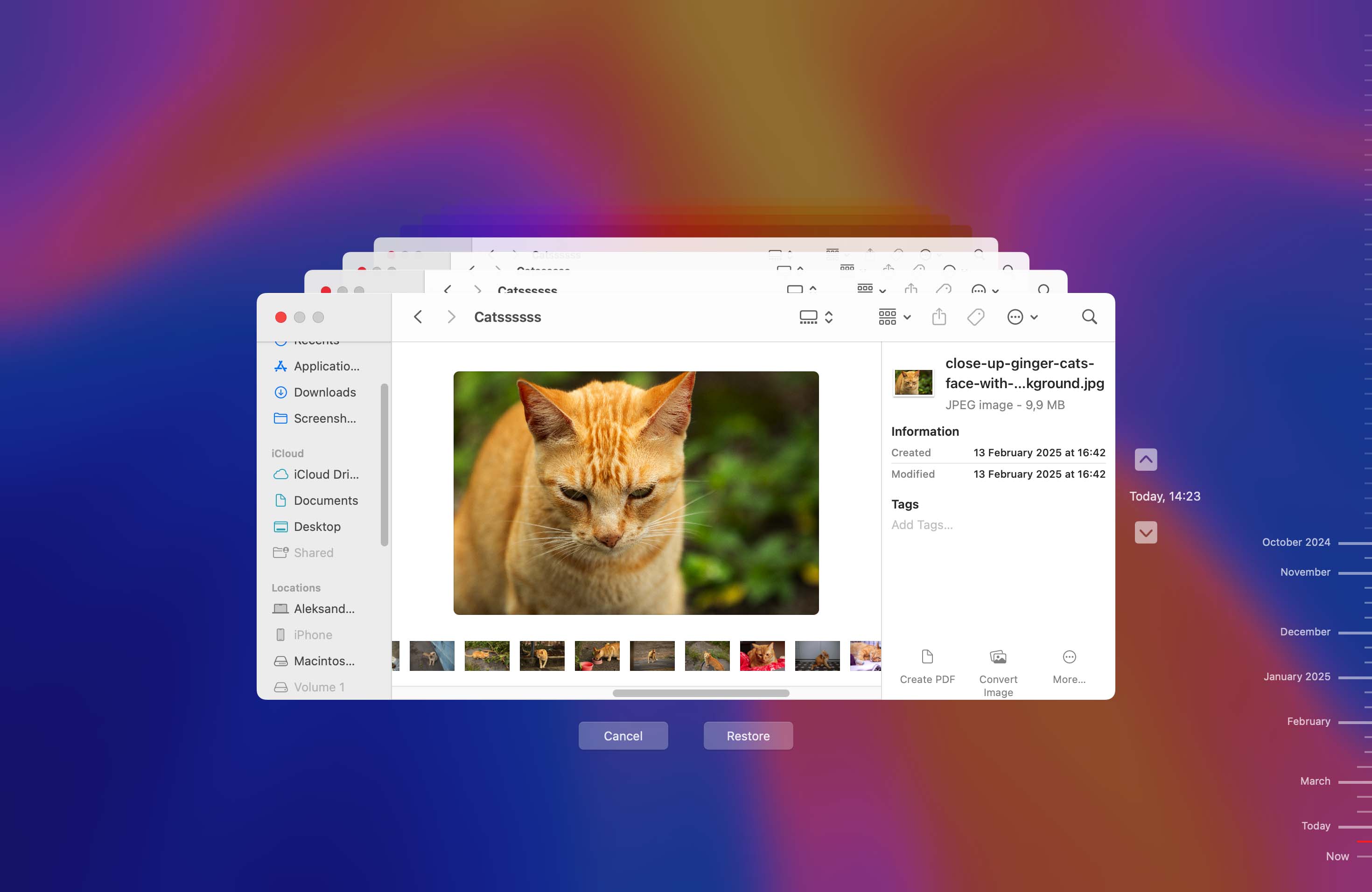
Again, your exact procedure will vary based on the type of backups that you perform. Whether you have backed up to the cloud or an external storage device, there is a secure feeling that comes with knowing that you can recover all of your precious memories at any time.
Way 4: Get Back Photos from a Cloud Backup
Android users have it great because they can not only tell their smartphones to store photos on a removable SD card, but they can also take advantage of apps like OneDrive, Dropbox, or Google Photos to back up everything to the cloud.
If that’s your case, then you should be able to recover each and every deleted photo just by downloading it from your cloud storage service of choice. Best of all, you can do so from anywhere and on any device, so this method can save you even if your original device has become stolen or lost.
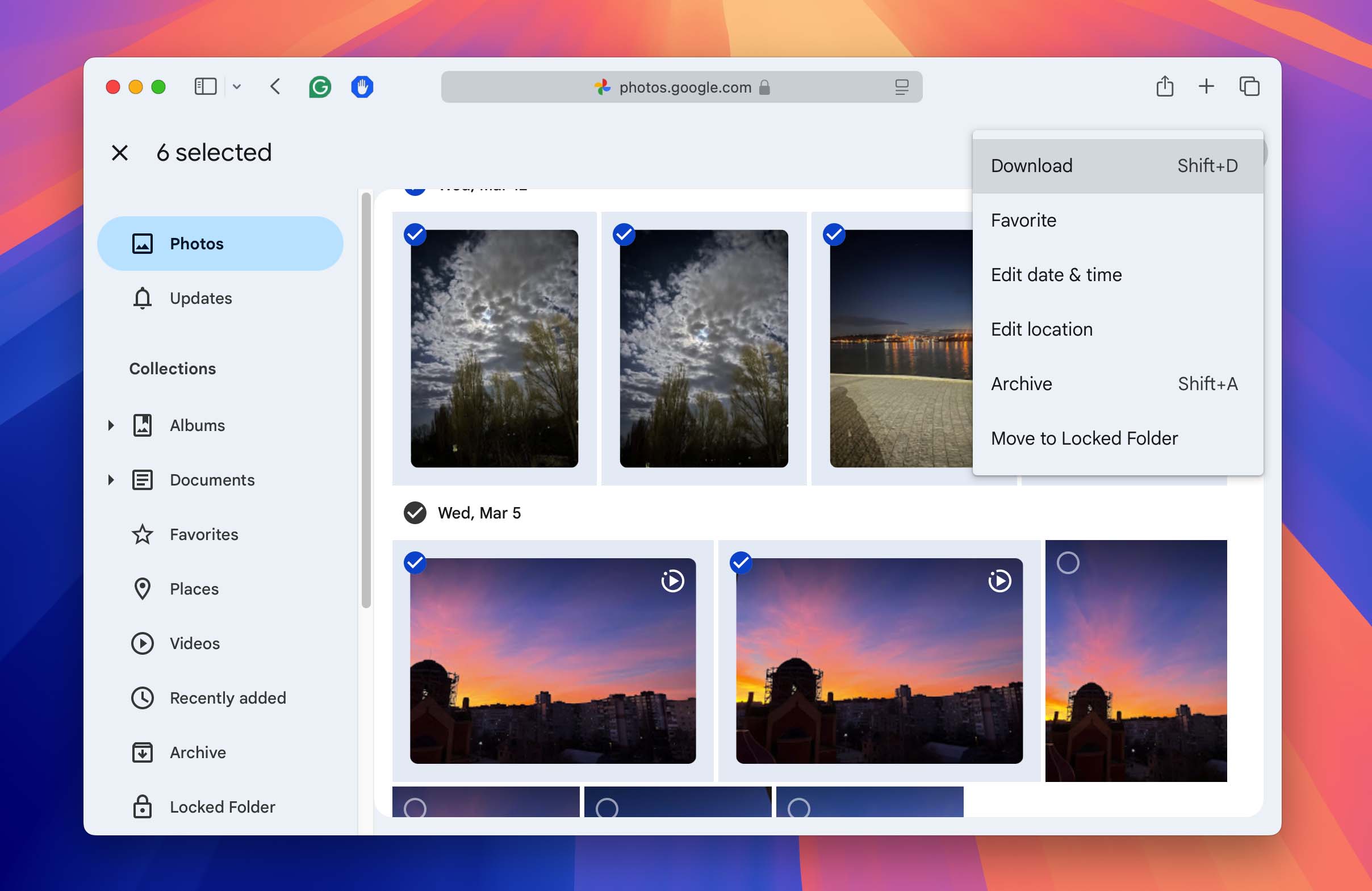
Use the following links to see official guides on how to download files from popular cloud storage services:
Do you use a different cloud backup app and are not sure how to download your deleted photos from it? Then we recommend you consult Google and look for a suitable guide.
Way 5: Retrieve Photos from Your Device’s Internal Memory or Storage
Be sure to check your device’s internal memory or temporary storage on Mac or Windows PC. When you delete a photo on your device, it is logically deleted and its storage space is marked as available, allowing new data to overwrite it at the same location. It is not immediately physically removed from your SD card.
Of course, you can also restore the deleted photos from apps that retained copies of them, such as Photos on macOS. The Photos app allows you to import photos from your SD card. In doing so, a copy of the photos will be moved to your Mac’s storage disk. If they’re deleted from within the app, you can then go to the Recently Deleted folder and quickly restore them.
A similar procedure can be performed using the various photo gallery apps found on Android devices.
Way 6: Recovering Photos From the Recycle Bin
In case you weren’t aware, there is a place where files go before they’re permanently deleted on Windows and macOS. On Windows, this is Recycle Bin. On Mac, it’s Trash. The two work very similar to each other, with only slight differences.
On Windows
Windows will send any file you delete to the Recycle Bin unless it’s either permanently deleted or too large to be stored in the Recycle Bin.
Here’s how you can restore files from the Recycle Bin on Windows 10 and 11:
- Open Recycle Bin on your Desktop.
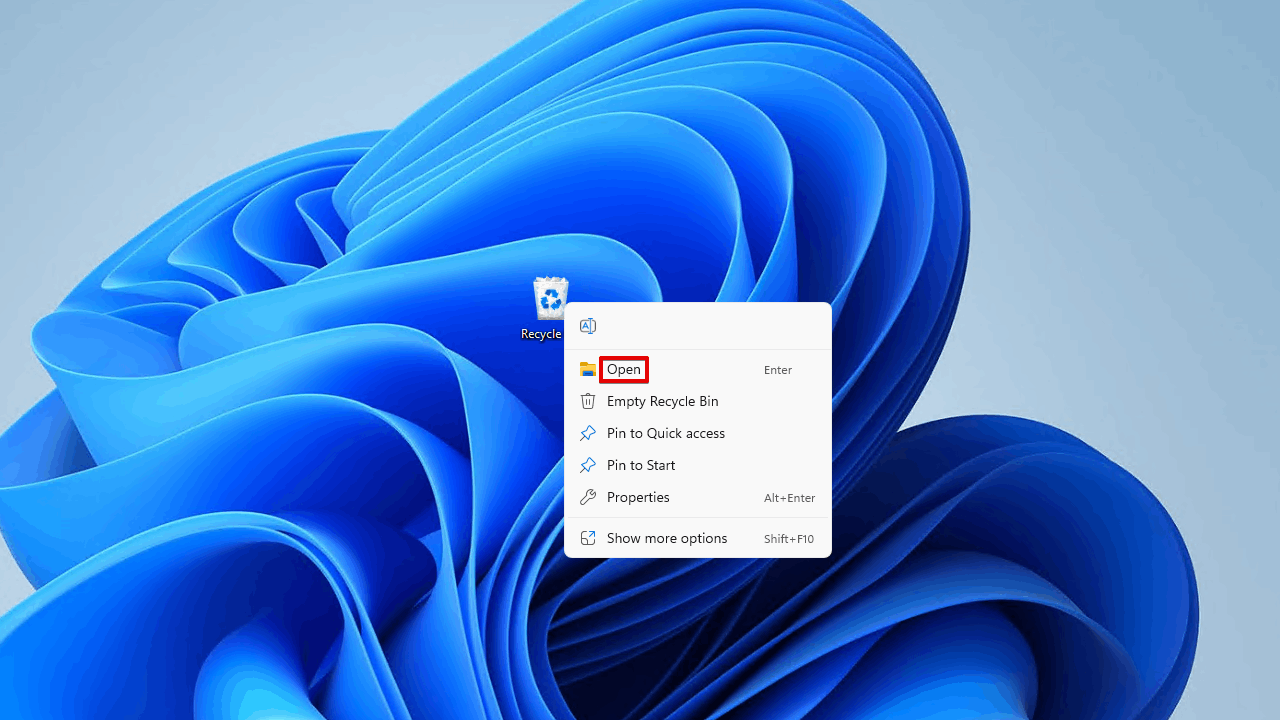
- Select the data you want to restore, then click Restore the selected items.
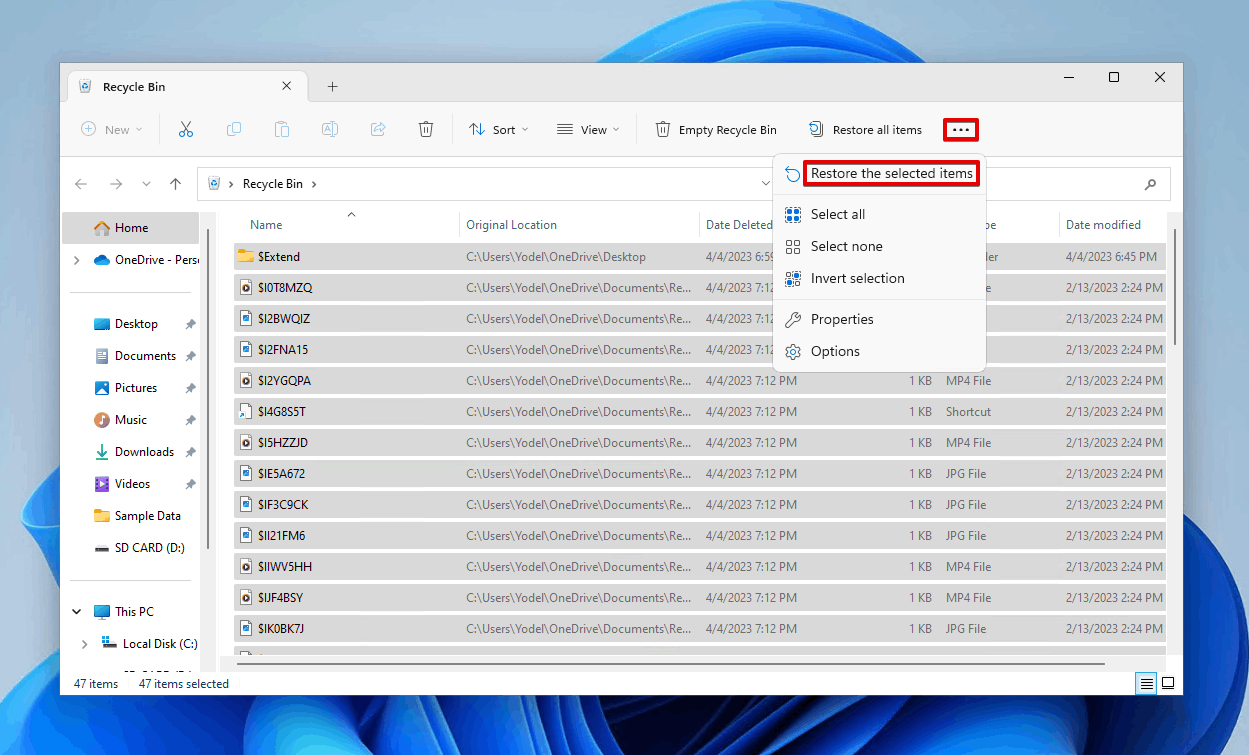
This will restore the items back to their original location. If you want to restore them elsewhere, simply drag and drop them out of Recycle Bin and into another folder.
On Mac
The process of restoring data is similar on macOS.
- Open Trash using Finder.
- Drag and drop the files to a safe location.
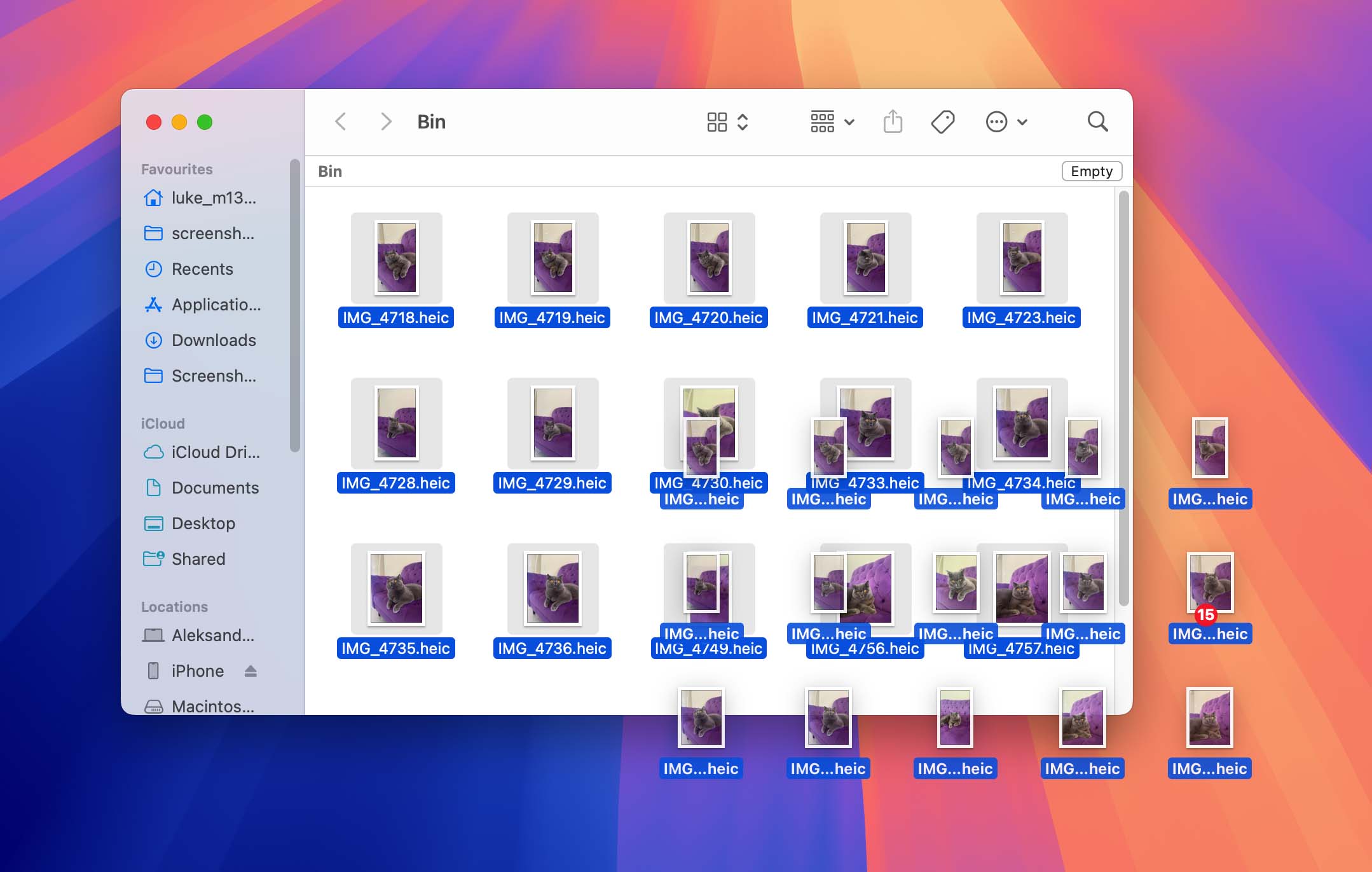
When you delete files from an external storage device on older versions macOS, it creates a hidden .TRASHES folder on the device. On prior versions of macOS, you could access it by going to the root directory of your storage device and showing hidden files, but now you will need to use third-party applications like Commander One to access this.
Wrapping Up SD Card Photo Recovery
What’s important when you’re trying to recover SD card photos from an SD card on Mac, Windows, or even Android, is that you act quickly. Photos that have been deleted can still be recovered, whether they were deleted by accident or became missing due to some form of SD card corruption.
Much of the time, you can recover the data yourself using data recovery software. However, in cases where the SD card is no longer being read, you should consult a data recovery service instead. It’s important to note that, even if you do fix the problem, more issues are likely to arise and you should replace the SD card instead.
FAQ
To recover deleted photos from an SD card:
- Download and install Disk Drill.
- Connect the SD card to your computer and launch Disk Drill.
- Scan the SD card.
- Select your deleted photos.
- Recover them to a safe location.
You can use a free SD card recovery application. Here are three popular options:
- Disk Drill (100 MB for free with Windows version)
- PhotoRec (Windows, Mac, and Linux)
- Windows File Recovery (Windows)
Disk Drill has an easy-to-use graphical user interface, while PhotoRec and Windows File Recovery are command-line utilities.
Unfortunately, it’s not possible to recover deleted photos from a memory card without software. You can, however, go through your backups and look for them there. Some digital cameras automatically create backup copies and store them in the internal memory, so make sure to look there as well.
Android users can download an SD card recovery app called DiskDigger directly from the Google Play Store and use it to recover deleted photos with a few simple taps. The basic version of DiskDigger is free, but there’s also a paid version that includes several extra features.
If your SD card has been formatted, then we will want to use a third-party recovery software to recover the files from the storage device. Keep in mind a formatted SD card doesn’t have the highest chance for data recovery, especially after a full format, but it’s worth trying.
Follow the steps listed in the article above and that will allow you to scan and recover any files that Disk Drill can find.



